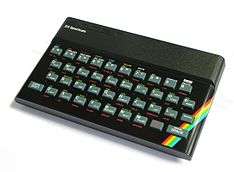MK14
|
MK14 (foreground) with modern reproductions behind | |
| Also known as | MK14 |
|---|---|
| Manufacturer | Science of Cambridge |
| Type | computer kit |
| Release date | 1977[1] |
| Introductory price | UK£39.95 |
| Units sold | 50,000 |
| CPU | National Semiconductor SC/MP (INS8060) |
| Memory | 256 bytes of RAM (expandable to 640 bytes) |
| Display | 8 or 9 red light-emitting diode (LED) seven segment display |
| Input | 20 key keyboard |
The Microcomputer Kit 14, or MK14 was a computer kit sold by Science of Cambridge of the United Kingdom, first introduced in 1977 for UK£39.95,[1] and which eventually sold over 50,000 units.
It used a National Semiconductor SC/MP CPU (INS8060), 128 (expandable to 256) bytes of random access memory (RAM) which was directly expandable to 640 bytes on board and 2170 bytes total. It used an 8 or 9 red light-emitting diode (LED) seven segment display, there was also optional VDU supporting 32×16 text or 64×64 graphics. Input and output was a 20 key keyboard and reset switch, with an optional 128 bytes of RAM and 16 I/O lines available by adding an INS8154N RAM/IO chip. Cassette-based and PROM storage were optional extras, a sound card was not included but a design for one was provided.
The MK14 could address up to 64 KB of memory space by adding a few chips (the NADS address strobe indicated when the most significant 4 bits of address were available to be captured by an external latch); many pioneering home-brew computer magazines such as Personal Computer World, and Practical Electronics carried details of user modifications.
Notes
See also
External links
- Old-computers.com dedicated page, article, pictures, documents and videos
- The Sinclair / Science of Cambridge MK14 Web Site, includes emulator software
- Making a reproduction MK14 – includes original manuals/schematics

